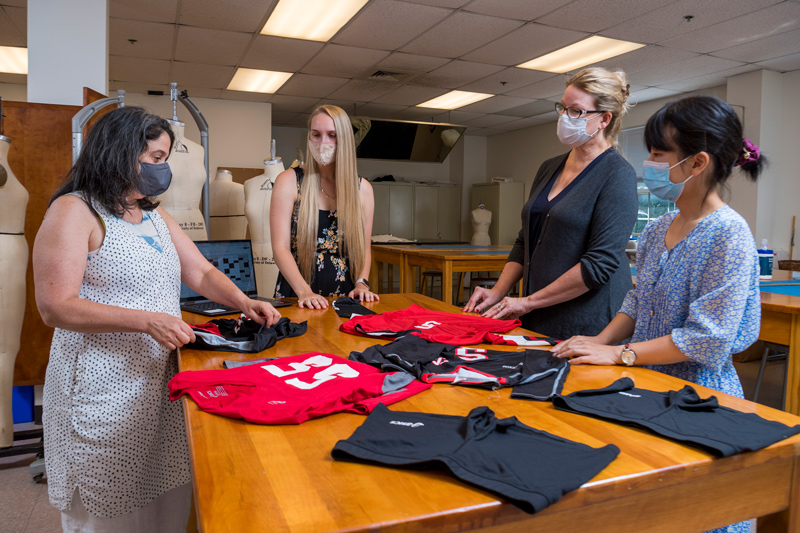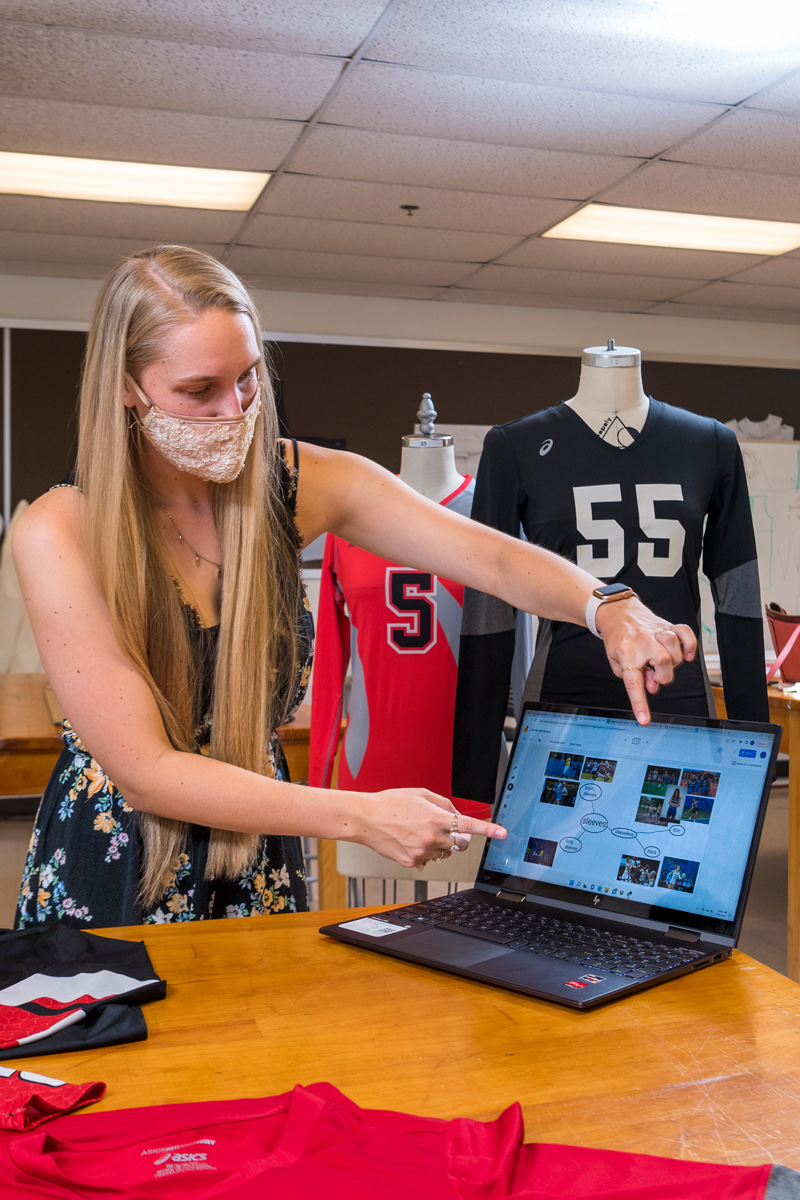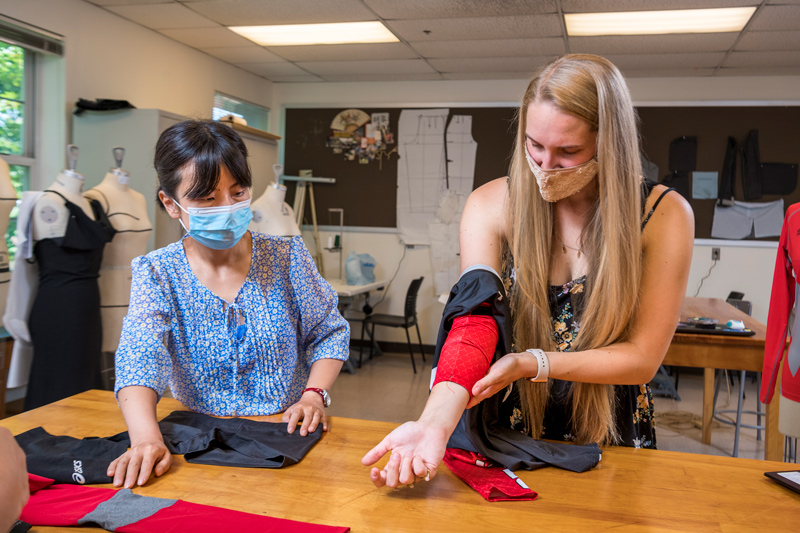


Fash-a-letes
Photos by Kathy F. Atkinson August 26, 2022
Summer Scholar Jenna Tomasch works on athletic apparel design and research
Jenna Tomasch, a sophomore fashion design and product innovation major and a student in the Honors College at the University of Delaware, recalls trying on her high school volleyball uniform and not being happy with the way it fit. The size small was too tight in the chest and offered limited mobility in the shoulders — necessary for serving, blocking and diving in a volleyball match. The size medium fit better in the chest but was then too loose in the waist, and Tomasch found the extra fabric to be distracting.
Now as a Summer Scholar working with Professor Kelly Cobb, Professor Belinda Orzada and international scholar Jie Diao, Tomasch is hoping to address some of the frustrations she faced as a student-athlete by utilizing direct observation, visual analysis and focus groups to understand performance wear needs for collegiate athletes. Though Tomasch does not play volleyball at UD, she hopes that by combining her research with her experience playing the sport at the high school level, she will be able to help improve performance for athletes at UD and beyond.
“To make athletes more comfortable and confident — that's really what we're focused on, because that's what's really going to improve performance,” said Tomasch, who has been dubbed by Cobb as a fash-a-lete. “We want to make sure that garments are comfortable to wear so that way they're not restricting movement. But also let's be honest, if you're not confident and comfortable in your uniform, you're not going to play well, so we really want to make sure that things fit the way athletes want them to so that they can play to the best of their ability.”

Athletic sports apparel is more than a uniform or means of identification — it is designed to improve performance during workouts. Athletic apparel companies tend to focus on ergonomics, or how clothes fit on the body, to promote maximum athletic performance and reduce the chances of injury when creating sports apparel. Tomasch hopes to bring athletes’ feedback to the forefront.
“This research is unique as it combines the expertise of the athletes with the fashion student, a combination of skills we see as superpowers for innovative design research,” Cobb said.
Tomasch started the project by polling female student-athletes at various colleges and universities about their uniforms, asking questions about fit, comfort, durability and “hacks” — or modifications — they make to their uniforms to make them more functional, such as rolling up sleeves. She also did a visual analysis of all of UD’s women’s uniforms, comparing the fit and lengths of tops, bottoms, sleeves and socks across many different sports. After compiling results from the survey, Tomasch decided to focus her research on volleyball uniforms since she has experience playing the sport.
Tomasch spoke with UD’s women’s volleyball coaches and equipment manager and sent a survey to the players; she plans to use the survey responses to get a better sense of ways to improve volleyball uniforms. Her goal by the end of the summer is to create drawings of different concepts. After that, if she continues her research beyond the 10-week Summer Scholars Program, the next steps would be creating a few different prototypes that athletes could test and Tomasch could evaluate.
“That's the wonderful thing about preliminary research — that it can lead you in so many different directions if you keep your mind open,” said Orzada, one of the professors with whom Tomasch is working this summer.

Tomasch’s research focus is on collegiate athletes since they don’t receive the same attention as professional or Olympic athletes. Her findings, she said, could then trickle down to the high school level or even youth sports. She also decided to focus her research on women’s volleyball uniforms specifically not only because she has experience as a female athlete in the sport, but also because, when women first started playing sports, women’s athletic gear didn’t yet exist. So what did women do? They threw on the men’s jersey and played.
“The issue is that sports gear and sports apparel is made traditionally based on men’s sizing,” Cobb said. “There have been wonderful innovations in sizing, but many of the more traditional companies still use the traditional sizing charts, which are based on men's bodies. And when women's bodies are in movement, there's a whole different criteria that we need to design for.”
While many sports apparel manufacturers focus on creating “athleisure” apparel — athletic and leisurewear, combined — that appeals to the masses and not just athletes, Tomasch and Cobb have decided to focus on the athlete. In essence, Cobb said this work is about making clothes that meet function and fit requirements by including the wearer into the design.
“Ideally, we would all have clothing fit to our shape, our movements and our expression,” Cobb said. “The overproduction of clothing that does not meet consumer needs is unsustainable. We foresee a future where co-creation and customization of clothing will be the norm.”
Tomasch isn’t positive she wants to work in the sportswear industry after graduation — she’s only a sophomore, after all, and she said she loves evening gowns as much as she loves athletic apparel — but it’s undeniable that the research experience will offer her a competitive edge in the job market.
“There's no formal program right now that pairs fashion and sport in this way,” Cobb said. “We do have a wearables class, and there's summer research, but we really see this as a valuable opportunity. I think that the sports brands are looking for this expertise, so we want to nurture that.”
Contact Us
Have a UDaily story idea?
Contact us at ocm@udel.edu
Members of the press
Contact us at 302-831-NEWS or visit the Media Relations website

